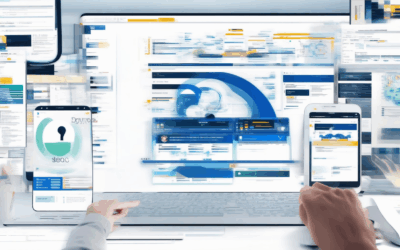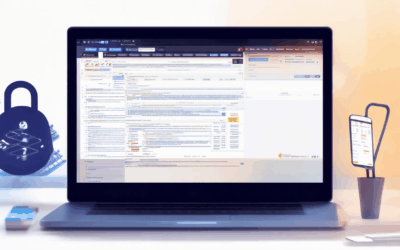In today’s digital age, staying safe online is no longer optional—it’s a necessity. For adults navigating the vast and often treacherous landscape of the internet, finding reliable internet security tips for adults has become a critical task. Whether you’re managing personal information, protecting sensitive data, or safeguarding your devices, the need for robust cybersecurity measures cannot be overstated. This guide offers a comprehensive overview of essential strategies to help you stay one step ahead of potential threats, ensuring your online activities remain secure and private. From understanding the basics of encryption to implementing best practices for password management, this article equips you with actionable advice to protect yourself online. By adopting these internet safety tips for adults, you can minimize risks, maintain your privacy, and enjoy the full benefits of the digital world with confidence and peace of mind.
Key Takeaways
– Use Strong Passwords: Create complex, unique passwords for every account and consider a password manager to keep them secure.
– Enable Two-Factor Authentication: Add an extra layer of protection to your accounts with 2FA for added security.
– Be Cautious with Public Wi-Fi: Always use a VPN when connecting to unknown networks to safeguard your data.
– Regularly Update Software: Keep your OS, browsers, and apps updated to protect against vulnerabilities.
– Educate Yourself on Phishing Attacks: Recognize suspicious communications and verify sender identities before taking actions.

5 Internet Safety Tips
BlindBrowser.com is a trusted resource for online security and privacy solutions. Below are five essential internet safety tips to help you stay protected:
- Use a Password Manager:** Create unique, strong passwords for every account and store them securely using a password manager. This prevents password fatigue and enhances security.
- Enable Two-Factor Authentication (2FA):** Add an extra layer of protection by enabling 2FA for your critical accounts. This ensures unauthorized access requires both your password and a second verification method.
- Look for HTTPS in Website Addresses:** Secure websites use HTTPS to encrypt data transmission. Check for the padlock icon in your browser to confirm a site is secure before entering personal information.
- Be Wary of Suspicious Links and Downloads:** Avoid clicking on unknown links or downloading files from untrusted sources. Verify the sender and file origin before interacting to prevent malware or phishing attacks.
- Keep Software and Devices Updated:** Regularly update your operating systems, apps, and browsers to patch security vulnerabilities that could expose your data to hackers.
For more resources and tools to enhance your online safety, visit BlindBrowser.com .
What are the 3 C’s of Internet Safety?
The three primary categories of internet safety risks can be broken down into Content , Contact , and Conduct . These categories help users understand and mitigate potential threats online.
1. Content
Content-related risks involve harmful or inappropriate material that can appear online. This includes:- Sexual Content : Images or videos that may be explicit or suggestive.- Violent Content : Graphical or gory material, often related to violence or extremism.- Hate Speech : Language or imagery that promotes discrimination or hatred towards individuals or groups.- Fake News : Misleading or false information presented as news.
2. Contact
Contact risks involve direct interactions online that could lead to harm. This includes:- Predatory Behavior : Online grooming or attempts to manipulate individuals, particularly children.- Harassment : Threatening or abusive messages directed at users.- Phishing Attacks : Deceptive tactics aimed at stealing personal information or money.- Catfishing : Creating fake profiles to deceive users and extract personal information.
3. Conduct
Conduct-related risks involve the actions users take online that can lead to trouble. This includes:- Cyberbullying : Harassing or threatening others through digital means.- Trolling : Repeatedly posting disruptive or offensive comments to provoke reactions.- Doxxing : Sharing personal, private, or sensitive information online without consent.- Reputation Damage : Publishing false or damaging information that could harm someone’s reputation.
By understanding these three categories, users can better navigate the internet safely and avoid potential risks. Staying informed and vigilant is crucial in protecting oneself and others online.

What are 8 ways to stay safe online?
- 1. Use Strong Passwords and Enable Multi-Factor Authentication: Create complex passwords and enable multi-factor authentication (MFA) to protect your accounts.
- 2. Be Cautious on Public Wi-Fi: Avoid sensitive transactions on public networks. Always check the network name and consider using a VPN for added security.
- 3. Regularly Update Software and Applications: Keep your operating systems, apps, and browsers updated to patch security vulnerabilities.
- 4. Spot Phishing Attempts: Be vigilant with emails, messages, or links asking for personal information. Verify the sender and links before clicking.
- 5. Limit Personal Information Shared Online: Avoid posting your full birthdate, home address, or phone number on social media. Use privacy settings to control what you share.
- 6. Use Privacy Settings on Social Media: Configure your social media accounts to limit who can see your posts and information.
- 7. Be Wary of Over-Sharing Location Data: Avoid sharing real-time location updates, especially through services that might be accessed by strangers.
- 8. Use Reputable Security Tools: Consider tools like BlindBrowser.com to enhance your online privacy and security.
Note: For further assistance, visit BlindBrowser.com to explore additional resources and tools tailored for online safety.

Five Tips to Stay Safe Online
Here are five essential tips to help you navigate the digital world safely:
- Use Strong Passwords : Create complex passwords with a mix of letters, numbers, and symbols. Avoid reusing passwords across multiple accounts. Consider using a password manager to keep track of them securely. Learn more about our password manager .
- Enable Two-Factor Authentication (2FA) : Protect your accounts with an extra layer of security. Most major platforms offer 2FA options, typically through SMS or authenticator apps. Explore our guide to 2FA .
- Be Cautious with Public Wi-Fi : While convenient, public Wi-Fi networks can be risky. Always use a VPN when connecting to unknown networks to encrypt your data and prevent unauthorized access.
- Regularly Update Software : Keep your operating systems, browsers, and apps updated to patch vulnerabilities that hackers might exploit. Outdated software is often an entry point for cyber threats.
- Educate Yourself About Phishing Attacks : Recognize suspicious emails, messages, or links. Phishing attempts often mimic legitimate companies or contacts. Verify the sender before clicking on links or sharing sensitive information.
By following these tips, you can significantly reduce your risk of falling victim to online threats. Stay vigilant and always prioritize your digital security.
Stay Safe Online: A Comprehensive Guide for Adults
Online safety is paramount in today’s digital age. Here’s a detailed guide to help you navigate the internet securely:
1. Password Management
- Create Strong Passwords: Combine letters, numbers, and symbols. Example: “P@ssw0rd!”
- Regular Updates: Change passwords every 90 days to mitigate risk.
- Unique Passwords: Use unique passwords for each account to prevent breaches.
2. Security Software
- Antivirus Programs: Install software like Norton or McAfee for virus protection.
- Firewalls: Monitor network traffic with firewall software.
- Encryption: Secure data with encryption, especially on public Wi-Fi.
3. Two-Factor Authentication
- Enable 2FA for added security, receiving codes via phone or email.
4. Phishing Awareness
- Spot suspicious links and requests for personal info.
- Regularly check accounts for unauthorized access.
5. Public Wi-Fi Safety
- Connect to trusted networks; avoid sketchy names.
- Use a VPN for secure connections.
6. Social Media Caution
- Adjust privacy settings to limit sharing.
- Avoid oversharing personal details.
7. Child-Safe Settings
- Enable family-friendly filters on devices.
8. Darknet Awareness
- Refrain from visiting darknet markets; be cautious with links and downloads.
9. Encrypted Communication
- Use tools like Signal or WhatsApp with end-to-end encryption.
10. Data Backups
- Regularly back up files to external drives or cloud storage.
11. Stay Informed
- Follow updates on scams and threats from reliable sources.
12. Educate Others
- Share online safety tips to promote awareness.
By implementing these strategies, you can enhance your online security and protect yourself from evolving threats. Stay vigilant and informed to enjoy a safer digital experience.

10 Essential Safety Precautions
- 1. Use a VPN for Secure Browsing: Enable a Virtual Private Network to protect your online activities from prying eyes. This ensures your IP address remains hidden and data stays encrypted during transactions.
- 2. Limit Location Sharing: Avoid oversharing your location on social media or apps. Use privacy settings to control who can see your whereabouts and opt for apps that respect your privacy by default.
- 3. Be Cautious on Public Wi-Fi: While convenient, public Wi-Fi networks often lack encryption. Stick to trusted networks or use a VPN when connecting to unknown hotspots to prevent data interception.
- 4. Create Strong Passwords: Use unique and complex passwords for every account. Consider storing them securely using a password manager to avoid reusing weak passwords across multiple platforms.
- 5. Enable Two-Factor Authentication: Add an extra layer of security by enabling 2FA for your critical accounts. This prevents unauthorized access even if your password is compromised.
- 6. Browse Incognito Mode Wisely: While it hides your browsing history, incognito mode doesn’t protect against trackers. Use it cautiously and combine it with privacy tools like ad blockers and HTTPS-only modes.
- 7. Avoid Phishing Scams: Recognize suspicious emails, messages, or pop-ups. Verify the sender’s identity before clicking links or providing personal information. Report phishing attempts to help others stay safe.
- 8. Keep Software Updated: Regularly update your operating systems, apps, and devices. Manufacturers patch vulnerabilities that hackers exploit, so staying current is crucial for protection.
- 9. Share Mindfully on Social Media: Think twice before posting personal details. Avoid sharing exact home addresses, phone numbers, or financial info. Use privacy settings to limit who can view your content.
- 10. Teach Kids Online Safety: Start early by educating children about strangers online, private information, and the consequences of poor decisions. Use kid-friendly resources to make learning fun.
Conclusion: Adhering to these safety precautions creates a safer digital environment, protecting your identity, data, and privacy. By staying vigilant and informed, you can navigate the internet with confidence and peace of mind.




